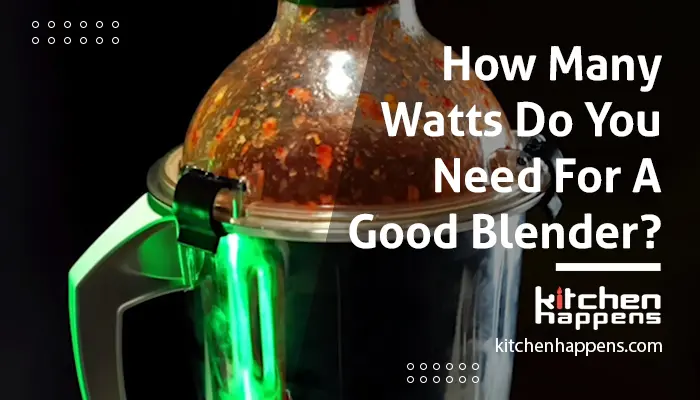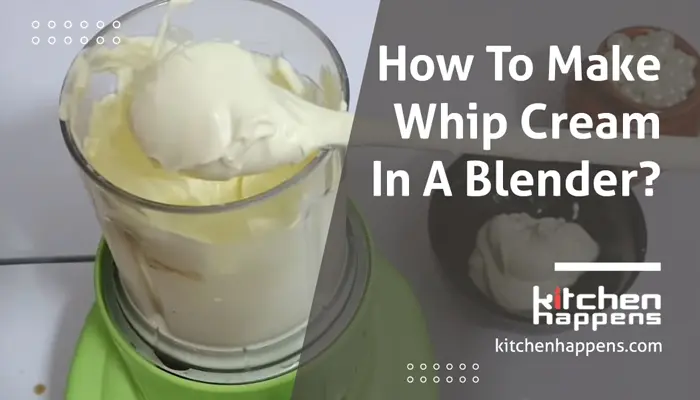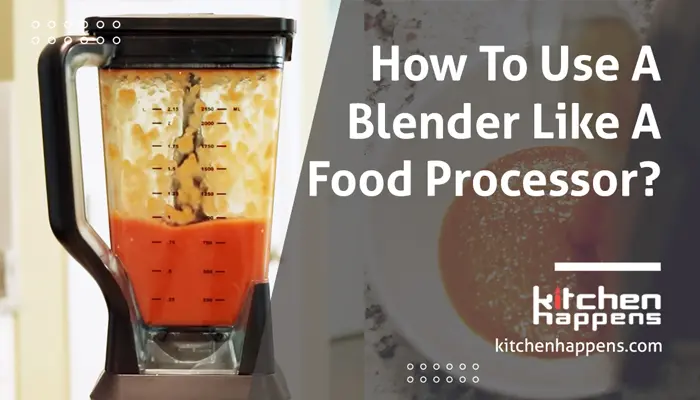Because of being one of the most multipurpose appliances, the blender is necessary for every home cook. From making smoothies to crushing ice and grinding nuts, a blender can shorten meal preparation time.
When you visit the store, you will find different types of blenders with different specifications. For example, some have a 450-watt while some have a 750-watt motor. And after noticing this variation, you must question how many watts do you need for a good blender. Right?
Well, this is one of the main features that define whether you are making a worthy purchase or not. So, knowing how many watts is good for a blender is a must.
We have thoroughly studied this matter and prepared this writing based on every piece of information that you need to know about this topic. And the first step is learning about what watts mean.
Explanation of What Watts Mean in Blender
Blender watts indicate the speed of the motor and its blending ability. The amount of potential power a blender can provide for any given task is measured in watts. Your blender will blend ingredients more smoothly and perform more tasks if it delivers more power to the blades.
A low-watt blender can make smoothies from fruits and leafy greens but will struggle with tough ingredients like coffee beans and nuts. But a high-watt blender can perform tasks like crushing ice, blending frozen fruits, and making nut butter in a blink of an eye.
Now, if you have ever thought of how to know if a blender is powerful, the watt is the answer. The higher the watt, the more powerful it is.
How Powerful Is A Blender Motor?
The blender motor power ranges from 300 to 1,000 watts. But, most models for household use fall within 500 to 750 watts. Some models use more than 1,000 watts which professional chefs usually use.
By the way, the wattage for the immersion blender starts at around 200 watts and can go up to 1000 watts.
Manufacturers usually specify blender moto speed in watts. However, sometimes you may see them using horsepower. So, for your information, 1 horsepower is equal to 746 watts.
A lower-watt blender motor runs on less power. On the other hand, a higher-end blender motor uses 1,000 to 1,560 watts.
Now, the question is, if a blender has higher wattage does it mean it has a strong motor? Well, more watts mean that the device can draw more power and has a stronger motor with powerful performance. However, this won’t always be the case if the build quality is poor or the components are cheaply made, which will make use of wattage less than optimal.

Higher wattage does make the motor work less to mix certain ingredients. As a result, the blender parts and blades will last longer, as well as the motor.
So, How Many Watts Do You Need for A Good Blender?
As you already know that the number of watts determines the power of a blender. Now does it mean you should opt for a higher wattage just because those are more powerful? The answer is no!
How many watts for a good blender depends on the type of job you are going to do with it. The rougher the blending task, the higher power it will require.
After using different types of blenders, I think the following ranges are sufficient.
- 250 watts is enough for handheld immersion blenders
- 300 to 600 watts is ideal for small personal blender performance
- Regular-sized blenders with 500 to 750 watts do well with the normal day-to-day task
- Professional blenders with 1200 to 1500 watts are the most efficient
A 500-watt blender is typically sufficient for most traditional home uses, such as blending fresh fruit for smoothies and milkshakes. However, a blender with at least 750 watts and preferably 1000 watts of power is recommended if you want to do more challenging tasks like grinding grains and coffee beans or making smooth dips, sauces, and frozen desserts.
If you want to prepare hot soups and add frozen fruit, whole vegetables, or leafy greens to your smoothies, you will need a high-quality blender with a motor that is at least 1500 watts in capacity.

Obviously, all of this is based on the blender being a high-end model from a reputable brand. Cheap machines are often built with low-quality components that cannot support the same loads as those made by leading manufacturers.
By the way, I have provided extended details on what wattage range is capable of doing what type of blending task in my next segment. When buying a blender, it will help you select the appropriate power for your desired job.
Blender Wattage Range And Their Capabilities
Depending on what you are trying to produce, you may require a blender with a different wattage. Many people wonder what a 250 watts blender is good for as it has low power, or when I need a 1200 watts blender.
After reviewing different blenders, here is my opinion on blender wattage and their capabilities and worth.
200 – 500 watts
If you will buy an immersion blender, this range is perfect. You can whip egg whites, puree baby food, blend soup, make the sauce, and mix salad dressing with this much motor power in an immersion blender. 450 to 500 watts personal blender is also great. But if a countertop blender has this range of wattage, it’s not worth getting.
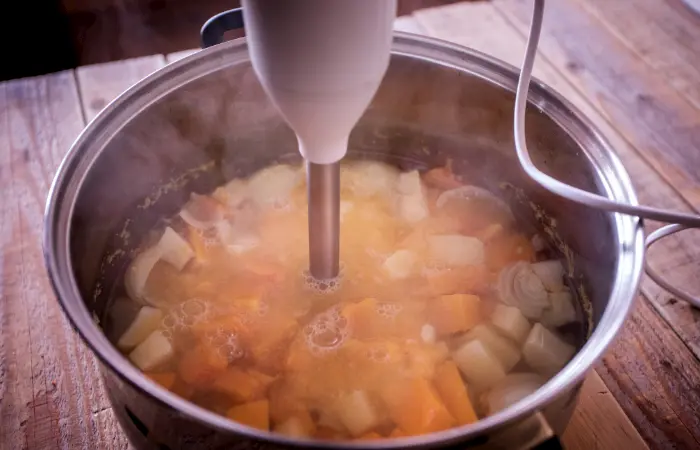
500 – 800 watts
This is a decent range for blending simple ingredients, but it won’t blend or puree super smoothly. Although some brands with 750 watts can blend frozen fruits, we can’t assure you because some models may fail to do so. But this range is excellent for blending smoothies with fresh fruit, making whipped cream, pureeing cooked vegetables, chopping different ingredients, etc.
800 – 1000 watts
This is the lowest range of wattage that I can confidently recommend. The reason is you can do almost every type of work, from crushing ice to making frozen fruit smoothies. Depending on the model, you may expect some chunks, yet this is a good option overall.
1000 – 1500 watts
.
This range is powerful enough for doing anything with a super smooth consistency and is best for home use.
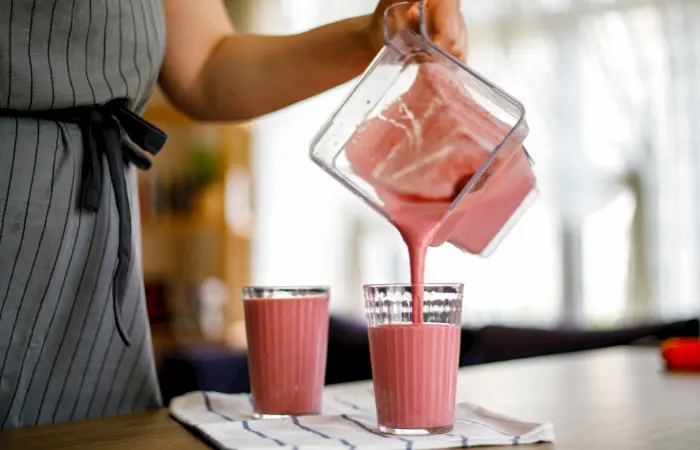
1500+ watts
Anything over 1500 watts will perform fantastically and is especially recommended to professional chefs. They not only blend better but will work faster and more durable.
Does A Blender’s Wattage Matter? Importance of Watts
Yes, wattage does matter when judging the quality of a blender. It defines how powerful your blender is. But this doesn’t always mean that the blender will be able to utilize this power efficiently. Higher wattage should indicate potent blending but not all the time.
Some debate that watts do not matter over a certain amount, while most experts agree that watts are significant depending on what you are blending.
A 500 watts blender isn’t able to pulverize the same way that a 1,500 watts blender is. If you want to crush ice into a fine snow-like texture, you have to go for a higher-watt blender. But, if you are looking forward to blending up soft, non-frozen fruits, then any blender would likely work.
When comparing blenders, wattage is an excellent starting point because it does represent the potential power provided to your blender.
However, there are a bunch of other factors that determine the overall quality of the blender. For example, if your blender has a high wattage, but the blades aren’t sharp enough to cut through, then the power is useless. In addition, you can judge a blender’s quality based on its adaptability, noise level, size, cost, features, and style.
In short, power is one of the essential measures but not the only one. A blender can utilize its power efficiently if its overall quality is up to standard. If you want a detailed guide on which factors you should consider, you may take a look at our article on how to buy a blender.
Types of Blender And Their Usual Wattage Range
Typically, there are 4 types of blenders available on the market. Here I will describe each of the types’ wattage range and what kind of job they are good at so that you can determine which is appropriate for you.
1. Professional Blenders
Professional blenders are powerful models with the maximum available watts. They can blend any meal to the proper smoothness thanks to their powerful blades and blender motor, which range in wattage from 1,200 to 1,700. Some professional blenders have more power than 1,700 watts.
Several professional-grade blenders can help you prepare food as well as do some of the cooking. For instance, some models with a wattage of 1,700 can heat your ingredients. Therefore it is perfect for making hot soups.
When it comes to blending leafy green into a smoothie, these powerful blenders stand out. Users claim that the texture and flavor of the smoothies have noticeably improved when they use professional blenders.
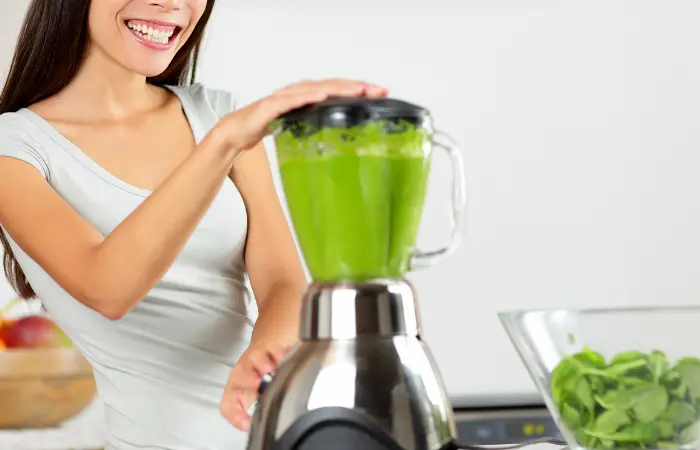
These blenders are for you if chunks in your smoothie are a deal-breaker or if you want to get the maximum flavor out of leafy herbs. They are also the most adaptable because of their high wattage and power. They can chop both dry and wet ingredients finely and also do more challenging tasks like producing nut butter or frozen sorbet with little to no liquid.
2. Standard/ Casual Use blenders
If you’re not devoted to using a blender daily, you can choose a blender with power between 500 and 750 watts. This is ideal for making fruit drinks for children and occasionally preparing food.
3. Handheld/ Immersion Blenders
Compared to regular blenders, immersion blenders use far less power and can function efficiently with as little as 150 watts, though some models have 300 watts. Hand blenders are specifically designed to blend soft ingredients like mushy fruits and soups. They can also be used as fantastic whisks to create a puree.
4. Personal/ Single-Serve Blenders
Personal blenders typically have a power range of 600 and 1,000 watts. As the name suggests, these blenders are for personal use for making a single serve. You won’t be able to make large portions. Models with high wattage can be used for ice cubes and coffee beans. These are most popular among fitness lovers who like to blend protein powder shakes quickly.

Some Renowned Blender Brands And Their Usual Wattage Range
Since consumers have different requirements for blending, manufacturers also developed many models with various wattages. Here I will tell you about a few brands you may look up to.
Vitamix
A comparison search for the Vitamix blender found that they run anywhere from 500 to 4000 watts. The Vitamix also offers multiple speeds, which increases its power and efficiency.
Nutribullet Pro
Nutribullet Pro is one of the most demanding products from this brand. It uses 900 watts and is a great choice for a personal blender. But note that it has limited capabilities. It only blends for 60 seconds at a time and has only one speed.
Other Nutribullet
The power of other Nutribullet blenders ranges from 600 to 1700 watts. For example, the Nutribullet Rx uses the most power, 1700 watts. This blender also has hot blending, which makes it ideal for soups. There are other models available with different power that you can check too.
Ninja
This brand sells blenders with power outputs between 1000 and 1600 watts. They have every type of blender, from professional and personal, to immersion and standard ones.
Magic Bullet
The magic bullet is a personal blender that is designed to save space on your kitchen counter. It has two wattages, beginning at 200 watts. The following model goes up to 250 watts. However, this blender is a limited-use product and does not offer multiple speeds.
Does A High Wattage Blender Use More Electricity?
Blenders with high wattages require a lot of power to operate. Therefore, they use much more electricity than blenders with low wattages. So, yes, they do use more electricity.

To make up for its huge power consumption, a high-powered blender can pulverize way more quickly than a low-power blender, meaning less electricity is used.
How Much Power Does A Blender Use?
The typical blender will consume 0.4 kWh per hour. But, the blender’s wattage and the time it runs both affect how much energy it needs every hour. Making nut butter would use more energy than simply blending fruit, even in the most expensive blender.
Advantages of Having A High-Powered Blender
Even though powerful blenders are a bit expensive, they work pretty fast. You won’t have to peel or chop your ingredients before putting them in your blender. Your produce will be chopped, pureed, or ground within seconds.
Except for these, high-powered blenders have a number of extra benefits, such as:
- It can be used in place of other appliances like food processors and coffee grinders.
- Able to puree foods into a smooth consistency
- Even the toughest foods can be chopped, ground, or pulverized
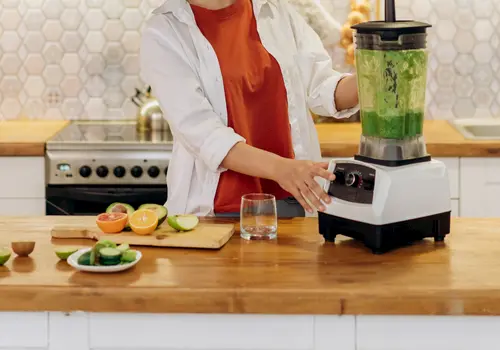
High-speed blenders can also be used for:
- Making hot soup with fresh vegetables
- Creating nut milk from nuts
- Preparing smooth and creamy smoothies from raw, unpeeled vegetables and fruits
- Milling flour
- Making batters and dough
- Chopping fruits and vegetables
- Making nut butter
- Grinding coffee beans
- Blending ice with flavors and other liquids
As you can see, high-powered blenders are capable of doing versatile jobs. If you don’t have any budget issues and want to make maximum use of a blender, you should definitely opt for a powerful blender.
Will A Powerful Blender Blow Fuse?
A blender blowing a fuse is definitely a rare case. Yet, in a few cases, a powerful blender may blow a fuse in your blender or your home. For example, blending thicker substances at a low speed may cause a blown fuse. That’s why while using a blender, you can take measures to avoid this.
When too much power is supplied to a blender at once, the fuse may blow. You can prevent this by using higher speeds for heavy ingredient loads.
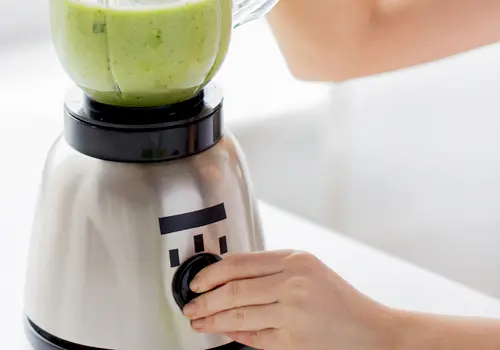
Additionally, use your blender on a different circuit or outlet than other large appliances. For instance, running a blender in the same area and at the same time as your microwave or air fryer in the kitchen can likely blow a fuse.
Moreover, read the user manual so you can use your blender safely, as most of them include warnings, instructions, and even recipes for different foods.
Final Words
Now tell me, how many watts do you need for a good blender? After going through the entire writing, you learned that it totally depends on what you plan to blend.
A 750 watts blender is fine if you only use it occasionally, mainly for soft foods. On the other hand, anything above is suitable for frozen fruit. And a blender with at least 1000 watts is best for versatile jobs, and it’s undoubtedly worth the slightly higher price tag.
Remember that blender wattage is one of the most crucial factors to its overall quality. A sharp blade and high-capacity jug will only be useful with high power. But, the quality also depends on size, functions, and a variety of other characteristics. So, don’t forget to consider them as well.
Frequently Asked Questions
Is 700 watts good for a blender?
The 700 watts base is powerful enough for blending soft foods. But, if you want to crush ice and blend frozen fruits, you need more power. We don’t recommend anything less than 800 to 1000 if you will use your blender frequently and for multiple purposes.
How many watts do you need to grind coffee beans?
If you want to grind coffee beans effectively, you should choose a 1000-watt blender. But 750 watts of power is also sufficient if the blender has sharp blades and excellent build quality.
Is 1200 watts good for a blender?
Yes, a 1200-watt blender is an excellent choice for your home kitchen. With 1200 watts, you can blend anything you need, including juices, smoothies, dips, and other things.
Is a 500-watt blender able to crush ice?
As crushing ice requires plenty of power, choosing a blender with a strong motor is essential. While 500 watts can be enough for a typical blender workload, you should consider at least 1000 watts or higher for ice crushing.

